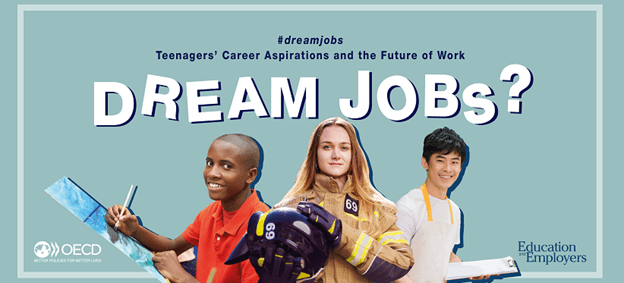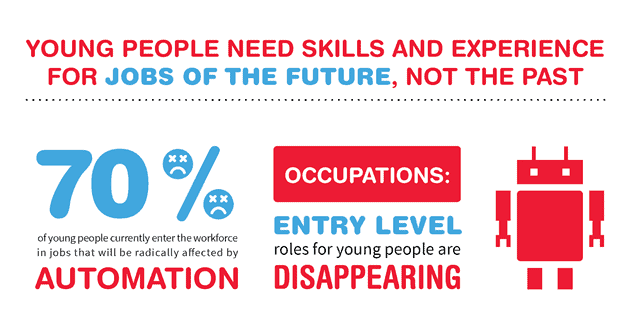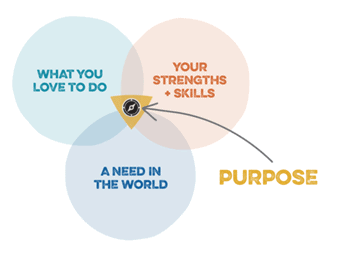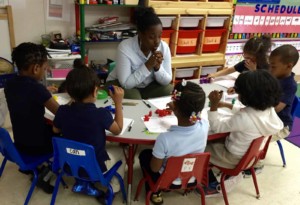Dream Jobs of the Innovation Age

By: Cameron Paterson
If you ask a kid today what job they would like to do when they grow up, the answers are still likely to be a police officer, doctor, or teacher. This hasn’t changed in the past twenty years.
In the meantime, the way we work is being fundamentally transformed. Automation is replacing work previously undertaken by people and the knock-on effect is that organizations are seeking people with different skill sets. Yet, the extraordinary changes to the world of work have had almost no effect on the career expectations of students. Rarely would we hear young people state that they wish to become a videogame designer, a director of culture, a sustainability coordinator, or an ethical hacker!
In the modern world of social media and artificial intelligence, it is still the traditional occupations that seize young people’s imaginations. The OECD report, Dream jobs: Teenagers’ career aspirations and the future of work notes that around 50% of young people expect to work in one of just ten jobs. And just when we are crying out for more innovative and entrepreneurial young people, automation has made it difficult for them to pick up the entry-level roles that previous generations used to gain insights into careers and learn new transferable skills. Without this sort of real-world experience, it is hard for young people to develop the capabilities that they need to thrive in the changing world of work. This has clear implications for career development in schools.

If we are willing to listen, the changing world of work is sending important messages about how we educate young people about the careers they are about to enter. Typically, career development in schools has been about providing information to help students decide what to do in their post-school life. Career guidance loosely relies on matching student interests to jobs. When careers educators see their role as narrowing down job options, it should not be much of a surprise when students express limited ambitions. Encouraging young people to believe that the world is predictable doesn’t prepare them for the fast-shifting, complex world they live in, and undersells their capacities to adjust to their reality.
Young people need to grasp a wider-ranging view of career opportunities and they need this knowledge earlier than they are currently receiving it. Delaying career education until high school is leaving it too late. Earlier career advice assists young people to select a pathway towards the role that will reveal their budding potential and funnel their interests in school. When students gain a deeper understanding of their evolving aspirations, their engagement in school has been shown to sky-rocket as they make connections between what they are learning in their classes and the opportunities they are beginning to generate for their future beyond school.
William Damon from the Stanford Center on Adolescence argues that “The biggest problem growing up today is not stress; it’s meaninglessness.” Lots of young adults are stressed not because they have too much to do, but because they don’t know why they are doing it. Adolescents who have a clear sense of purpose are happier, healthier, more engaged, and less stressed. Having clarity about purpose provides direction. Damon claims that: “Young people treasure guidance from experienced adults who care about them and know more about the world than they do. To be most helpful—and welcome—the guidance must speak to the youngster’s highest aspirations.”

Researchers have now made connections between career education and positive psychology, through developing a hope-centered model of careers development. Consider the potential if a school could increase student achievement, increase engagement with learning, and provide a clearer sense of possible future professional identities for young people. Increased levels of hope are linked to increased levels of student engagement and career clarity. In turn, increased levels of student engagement are connected to improved academic performance in schools. Putting energy into school-based initiatives that engender a sense of hope in the future seems like a sensible path for educators to pursue.
Organizational psychologist Jim Bright contends that we need to move away from static notions of “ideal career” or “perfect fit” and focus more on the skills of exploration, curiosity, adaptability, persistence, and embracing uncertainty. Become Education is working to open up the world of possibilities for every student as part of their career education program. They have been working with schools to run a PBL unit titled, ‘How can I explore my dream career?’ Liv Pennie thinks that a career program should be about learning the process rather than finding a single answer. It is hard for schools to create space for this within a crowded curriculum. Ideally, a careers program would have its own space from the elementary years up, as well as being integrated into all subject areas. Liv also believes that an important question to ask is whether career education is on the school strategic plan? Any school that advocates lifelong learning and preparing students to thrive in a rapidly changing world should be prioritizing the teaching of explicit skills to explore, design, and navigate the future.
Director of Student Opportunity and Careers Education Samantha McFetridge says that what is needed is, “a focus on skills not jobs. Students need access to a range of authentic learning opportunities to experiment with the world of work.” LearnLife in Barcelona laments the disconnect between the world of work and schools. They locate start-ups and external workers within the same space as their learning programs. Their aim is for young people to see more diversity in future jobs and careers. At Bradfield College in Australia, Grade 11 students work in an industry experience program connected to a Sydney Vivid Ideas project. This provides students with opportunities to work with creative industries and to produce for an external audience. Students get to see and feel what they might like to do after school. Australia’s Scientific and Industrial Research Organisation is conducting innovative virtual work experience for high school students.
Elementary teacher Amber Bidwell designed a program for Grade 6 students called ‘Thinking Ahead’. Parents attend every fortnight and present their career path to the students. Amber gives the parents prompting questions, such as ‘What did you learn at school that you use now?’, ‘Tell a time that you failed’ ‘What skills do you think are required in the workforce?’ The sessions widen students’ thinking about their future options and reinforce the success skills required in the workplace. St Luke’s Catholic College is engaging Life Coaches to assist students to answer the questions: ‘Who am I?’ ‘What are my strengths?’ and ‘What problems can I solve?’ Students learn how to unpack their strengths and interests, and determine their talents through passion projects which aim to improve life for others. At the end of Grade 8, every student articulates a draft life purpose statement.
Let’s not sit back and wait for events to unfold. Let’s find ways to develop transferable skills and career insights for young people. Let’s provide career education right down to elementary school levels and widen students’ vocational aspirations. Let’s help kids find their purpose and build their sense of hope in the future so they learn to thrive in this uncertain world and aspire to the dream jobs of the innovation age.
For more, see:
- 4 Ways to Develop Anti-Racism
- Your School Has Left the Building
- ‘Imagine Project’ Turns Trauma into Strength, Empathy, and Sense of Community
Cameron Paterson is the Director of Learning and Teaching at Shore School in Australia. Follow him on Twitter: @cpaterso.
Stay in-the-know with innovations in learning by signing up for the weekly Smart Update.






0 Comments
Leave a Comment
Your email address will not be published. All fields are required.